Affiliate disclosure: This post may contain affiliate links. Please see our Privacy Policy.
St. John’s Wort Salve is a time-honored herbal remedy for nerve pain, bruises, burns, and wounds. With its brilliant yellow blooms and signature red oil, this mid-summer herb has been used for centuries to support healing—especially for wounds and nerve-related discomfort.
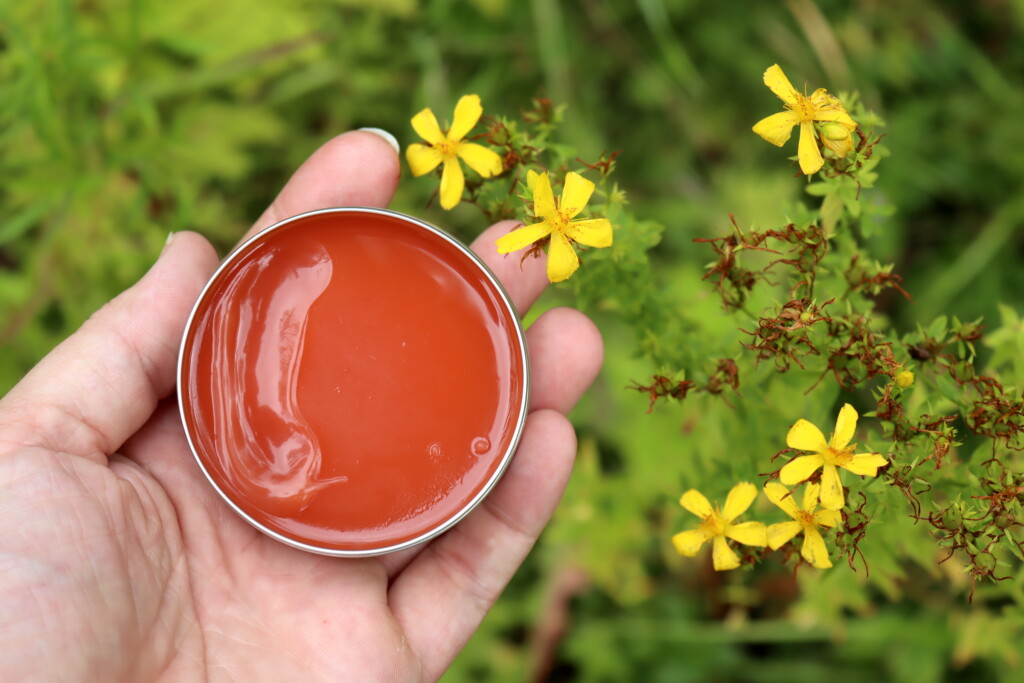
While St. John’s Wort (Hypericum perforatum) is better known today for its use in treating mild depression and anxiety when taken internally, its oldest and perhaps most enduring use is as a topical salve. According to legend, the herb got its name because it was used by St. John himself to treat battlefield wounds during the Crusades. “Wort” simply means “plant” in old English—so St. John’s wort is literally “St. John’s plant.”
On our homestead in Vermont, I look forward to midsummer when my daughter and I can gather st. John’s Wort to use the flowering tops to make herbal infused oil, the first step to making a herbal salve.
The flowers start a sunny yellow, but turn red when crushed. That red pigment is hypericin, one of the main healing compounds in the plant and what gives infused St. John’s wort oil its bright red color.
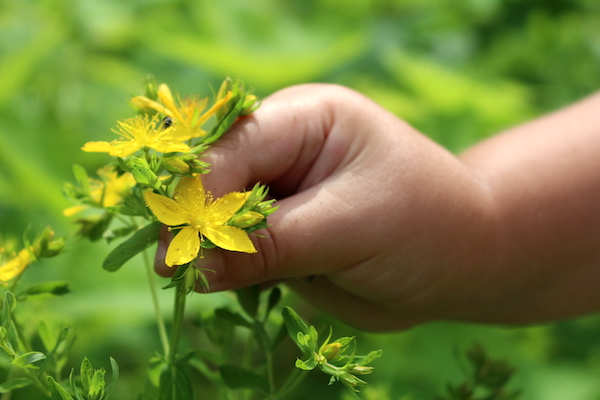
Today, I use St. John’s Wort Salve as a go-to for minor burns, bumps, bruises, and sore muscles (similar to calendula salve), but most importantly, for nerve discomfort like sciatica or for my dad’s tingling neuropathy (similar to comfrey salve). Since it’s antimicrobial, pain relieving and nerve soothing, it’s also a key ingredient in my herbal burn salve.
The salve is simple to make at home with fresh blossoms, and the process feels like a ritual I’ve carried on from centuries past.
If you’d rather buy than make your own, look for small-batch herbalists who infuse their oil from fresh flowers. You can purchase St. John’s Wort Oil already infused from fresh flowers, and at that point, all you need to do is craft the salve.
The oil should be deep red—a sign of a potent infusion. But if you’re able to harvest or grow your own, I promise the process is well worth the effort.
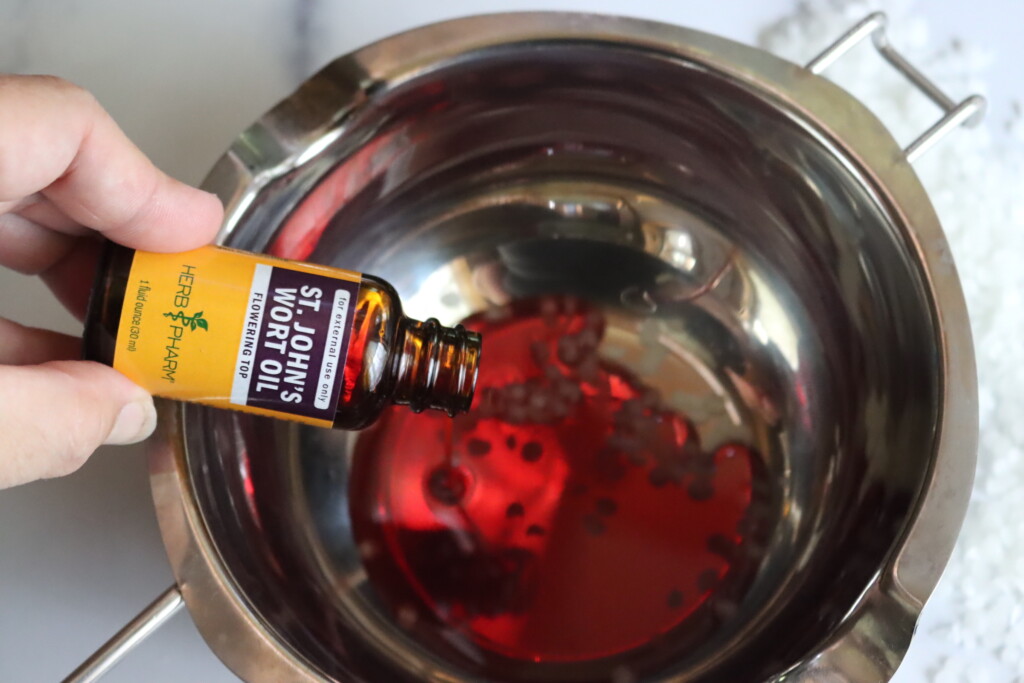
(St. John’s Wort is generally safe for topical use, but consult a healthcare provider before trying any new herbal remedy, especially if you’re on medications, pregnant, or nursing. Be 100% certain of your plant ID and use reputable sources when harvesting from the wild. This post reflects my personal experience and research—please use your own judgment and consult professionals when needed.)
What is St. John’s Wort?
St. John’s Wort is a perennial wildflower with bright yellow, five-petaled blossoms that typically bloom around June 24th—St. John’s Day on the calendar, hence the name. The flowers are cheerful and sun-loving, but the most important identifying feature is in the leaves.
If you hold one up to the light, you’ll see a spray of tiny translucent dots—these are oil glands, and they give the plant its botanical name “perforatum.”
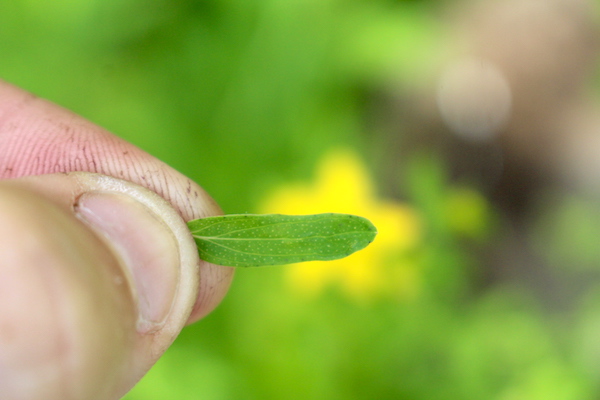
The flowers, buds, and seed pods, when gently crushed between your fingers, release a red or purplish juice. That stain is what infuses oil into its signature color—and it’s also a sign you’ve found the right plant.
Be sure to gather on a dry day; dew will prevent the pigments from expressing.
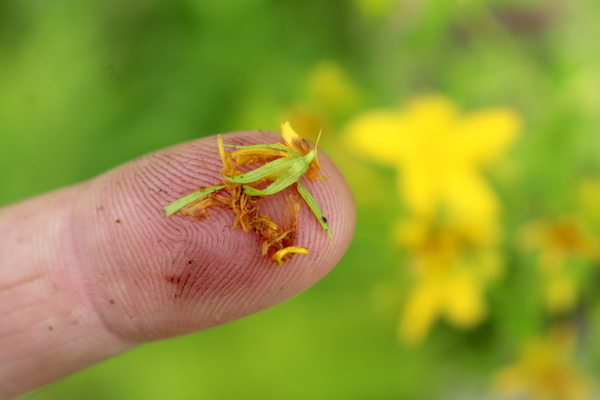
While the plant’s medicinal value is now widely acknowledged in modern herbalism and even clinical research, its uses date back thousands of years. Roman soldiers carried it to ward off “evil diseases,” and in the Middle Ages, people believed bringing the herb indoors at midsummer would ward off witches and misfortune—and possibly even prevent house fires.
That said, St. John’s Wort has also been used in far more practical ways. Crusaders reportedly carried the herb into battle to treat wounds, and over time it was used for burns, snakebites, menstrual cramps, stomach issues, exhaustion, and nerve pain. Many of those uses have fallen out of fashion, but salves and oils made from the plant remain some of its most trusted applications.
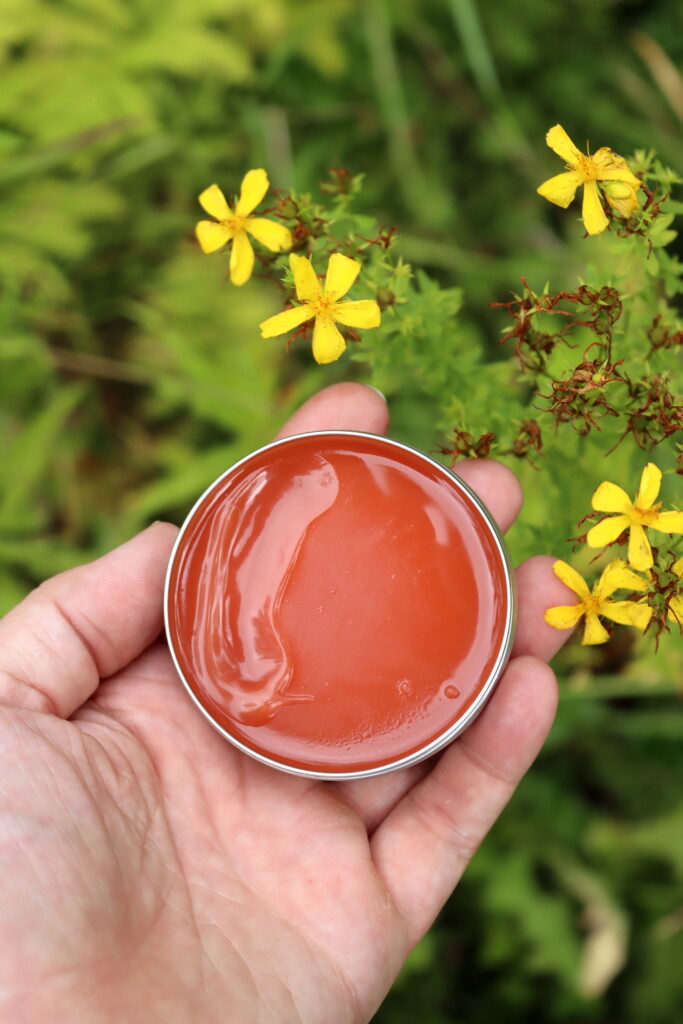
Benefits of St. John’s Wort Salve
St. John’s Wort Salve is known for its ability to soothe nerve-related pain, making it especially helpful for conditions like sciatica, shingles, and neuropathy. It also supports the healing of minor wounds, bruises, and burns—especially sunburn or kitchen burns.
Modern science backs up what folk herbalists have known for centuries. Clinical studies have shown that St. John’s Wort can help with wound healing, and its key compound hyperforin is known to inhibit Staphylococcus aureus, a bacteria resistant to penicillin and often found on the skin. The herb also contains hypericin and flavonoids that have anti-inflammatory, antioxidant, and antimicrobial effects.
From a practical standpoint, I’ve found St. John’s Wort salve to be one of the most useful summer remedies. I use it for sunburns, sore backs after haying, mystery nerve pain, and even bruises from little accidents around the homestead. It’s especially helpful when other “soothing” salves don’t quite reach deep enough.
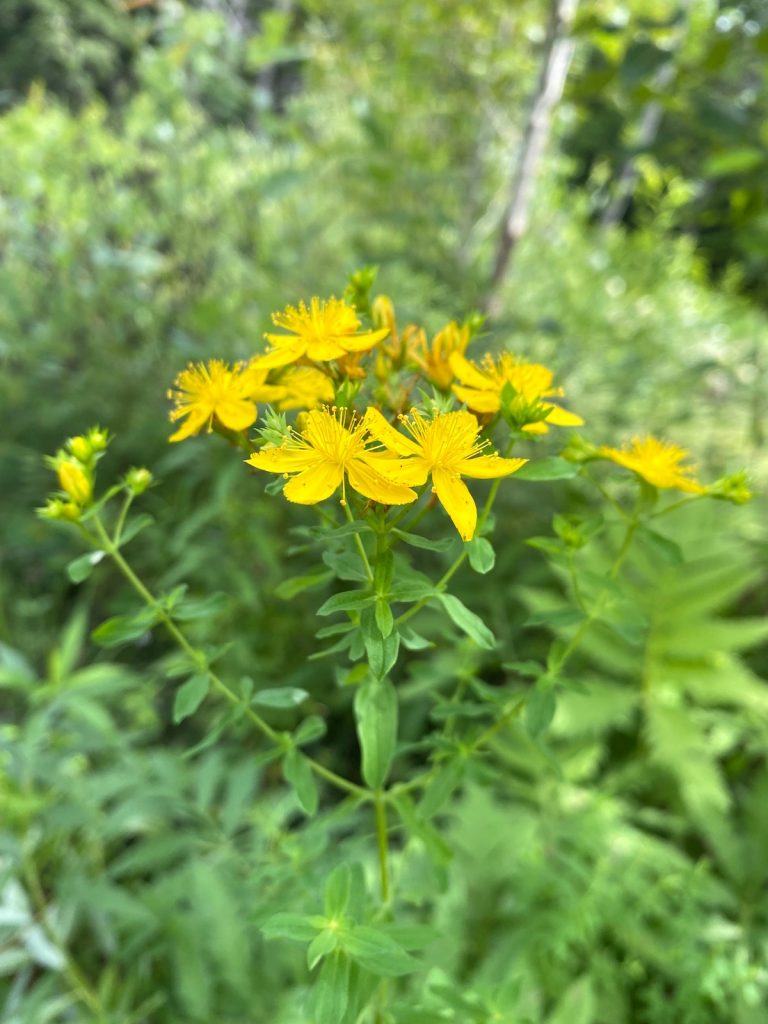
Identifying and Harvesting St. John’s Wort
You’ll find St. John’s Wort in sunny, disturbed areas—along trails, roadsides, and field edges. It grows prolifically in Vermont and much of the U.S., but you can also grow your own with St. Johns Wort Seed Packets.
Identifying St. John’s Wort is easy enough—the blooms are bright yellow with five petals and a burst of golden stamens, often appearing around the summer solstice in sunny, open areas.
The best time to harvest is when the flowers are in full bloom and you can still see unopened buds. That’s when hypericin content is highest. I usually snip the top few inches of the flowering stem and process the flowers as soon as possible to avoid any loss of potency. The oil needs to be made fresh—drying the herb first dramatically reduces its effectiveness.
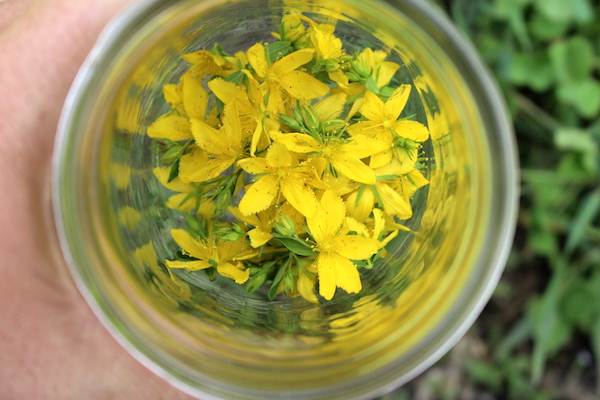
Supplies for Making St. John’s Wort Oil and Salve
To make the salve, you’ll first need to make infused oil. Here’s what you’ll need:
- Fresh St. John’s Wort blossoms
- A neutral carrier oil (olive, almond, jojoba, grapeseed, or coconut)
- Beeswax (white or yellow, pellets or shaved from a bar)
- A double boiler setup (or mason jar on a trivet in a pot)
- Fine mesh strainer or cheesecloth
- Salve tins or glass jars for storage
I prefer white beeswax for this salve so the red color really shines, but either works fine. One heaping tablespoon of pellets is roughly one ounce, or you can weigh it on a small kitchen scale for precision.
Herb Farm makes a pre-made St. John’s Wort Oil in 1 ounce bottles. It’s incredibly concentrated, and you can use it along with 7 ounces of neutral oil (like olive oil) to make the 1 cup needed for this recipe.

How to Make St. John’s Wort Salve
Start by filling a clean jar with fresh blossoms, lightly pressing them down but not packing too tightly. Cover completely with your chosen oil, leaving about 1 inch of headspace. Seal the jar and place it in a double boiler or similar setup. Keep the temperature between 110 and 120°F for 24 to 48 hours, checking the water level frequently.
I’ve found that placing the jar inside a dehydrator (with trays removed) is a great way to maintain the temperature during the infusion time.
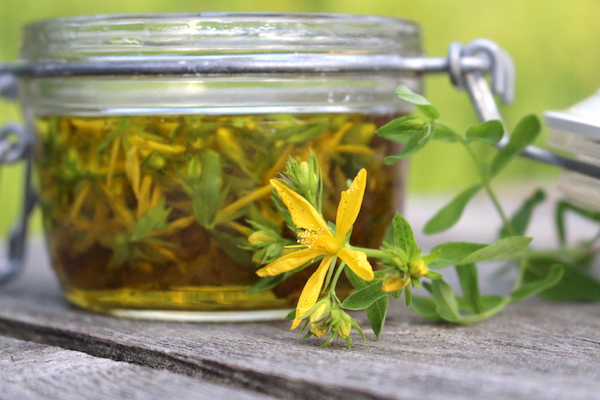
As the oil warms and infuses, it will gradually turn a deep red. This is a sign that the hypericin is extracting properly. After the infusion is complete, strain out the blossoms through a cheesecloth-lined funnel or fine mesh sieve, pressing to extract as much oil as possible.
To make the salve with the infused oil, return the infused oil to your double boiler and add about 1 ounce of beeswax per cup of oil. Stir gently over low heat until the wax is fully melted. Then, pour into salve tins or jars and allow to cool for at least 30 minutes before sealing. The finished salve should be firm but spreadable.
Store your finished salve in a cool, dark place and use it within a year. The color may fade over time, but the salve remains useful as long as it smells fresh.
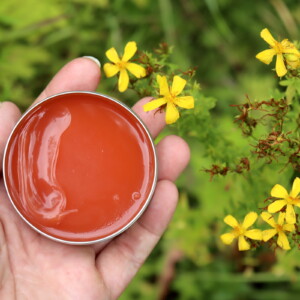
St. John’s Wort Salve
Ingredients
- 1 to 2 cups Fresh St. John’s Wort flowers Hypericum perforatum, lightly packed
- 1 cup neutral carrier oil olive, almond, grapeseed, jojoba, or coconut
- 1 ounce beeswax pellets or grated from a block; about 1 heaping tablespoon
Instructions
Making St. John's Wort Oil
- Begin by harvesting fresh St. John’s Wort blossoms on a dry, sunny day. Use scissors to snip the top few inches of the plant, focusing on fresh blooms and unopened buds. Gently crush a few between your fingers—if they leave a red or purple stain, you’ve got the right plant.
- Fill a clean, dry glass jar with the blossoms, loosely packed, and pour the oil over them until completely covered, leaving about an inch of headspace.
- Set the jar into a double boiler or create a DIY version by placing it on a canning ring or trivet inside a saucepan with a few inchs of water. Gently heat the oil infusion to between 110°F and 120°F, and maintain this temperature for 24 to 48 hours, checking and topping up the water as needed. (A dehydrator with the trays removed works well as an incubation chamber, as does an instant pot on “yogurt mode,” just be sure to put the oil in a jar and then add water to the instant pot to treat it like a double boiler for a gentle, even heat.) Over time, the oil will turn a deep red as it absorbs the plant’s healing compounds.
- Once infused, strain the oil through a cheesecloth or fine mesh strainer, pressing gently to extract as much oil as possible.
Making Salve
- Return the strained oil to the double boiler and add the beeswax. Warm the mixture over low heat, stirring until the beeswax is completely melted and the oil is smooth.
- Pour the warm salve into small tins or jars and allow to cool undisturbed for at least 30 minutes. Once set, cap the containers and store them in a cool, dark place. Use within one year for best results.
Notes
FAQs
Fresh St. John’s Wort flowers are essential for a potent, richly colored oil. The medicinal compounds that give the oil its red hue degrade quickly after drying. Using dried flowers will result in a weaker infusion, and you won’t get the deep red color or the same nerve-soothing properties.
The red color in St. John’s Wort oil comes from hypericin, which is released only from fresh blossoms and buds. If your oil stayed golden or greenish, the flowers were likely too dry or not fresh enough. Heat that’s too high during infusion can also degrade the pigment, so be sure to keep the oil under 120°F throughout the process.
When taken internally, St. John’s Wort can increase sensitivity to sunlight. However, topical use in the form of oil or salve is not typically associated with photosensitivity. Still, if you have sensitive skin or plan to apply large amounts before sun exposure, consider testing a small area first or covering the area with clothing.
If stored in a cool, dark place, St. John’s Wort salve should keep for up to a year. Exposure to heat and light will cause it to degrade more quickly. Discard the salve if it smells rancid or changes color significantly.
Herbal Remedies
If you’re diving into homemade herbal salves, you might also enjoy making Chickweed Salve, which is wonderfully cooling for irritated, inflamed skin and great for conditions like eczema, psoriasis, and bug bites. For pain relief, Dandelion Salve and Comfrey Salve are other soothing options—dandelion is especially helpful for sore muscles, while comfrey supports tissue repair and bruising.
Looking for more ways to work with this plant? Check out my guide on how to make St. John’s Wort Tincture for internal use, or explore other seasonal remedies in my collection of Herbal Healing Salves. Each recipe is designed with simple, whole ingredients you can grow, forage, or source locally.
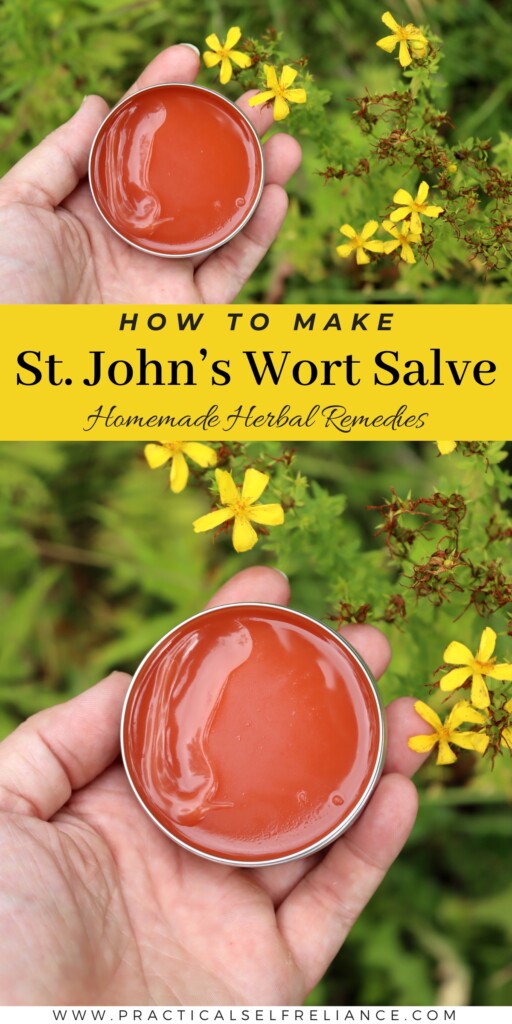
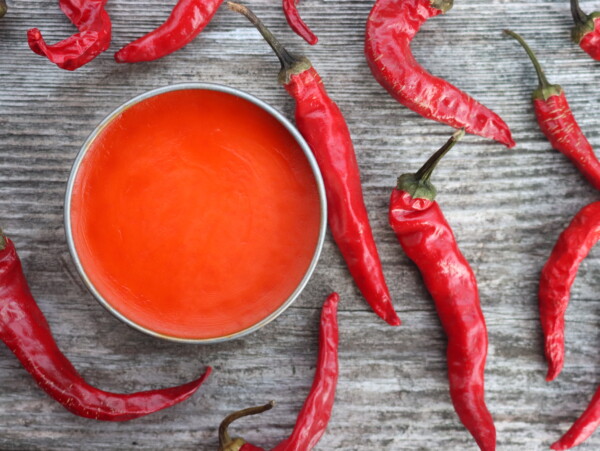
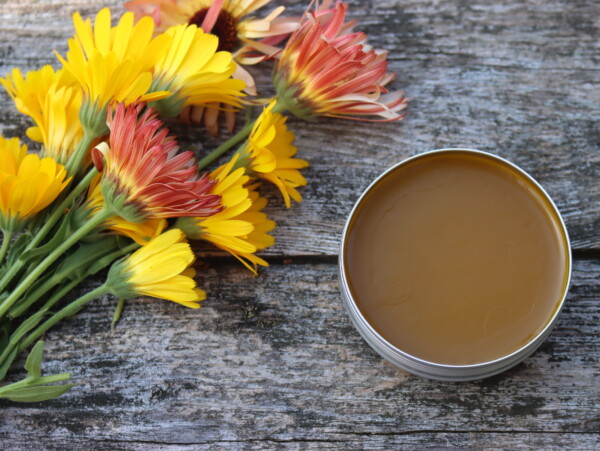
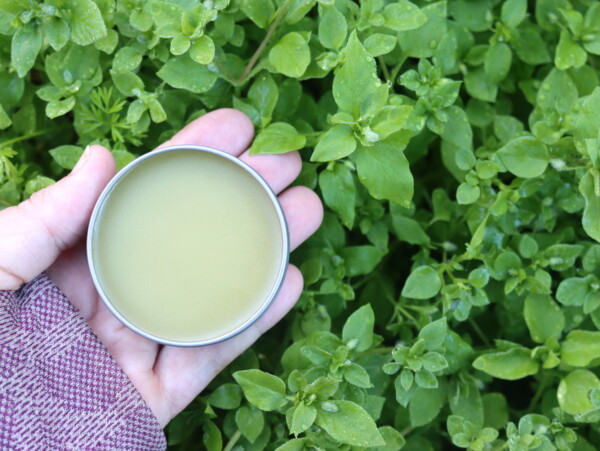
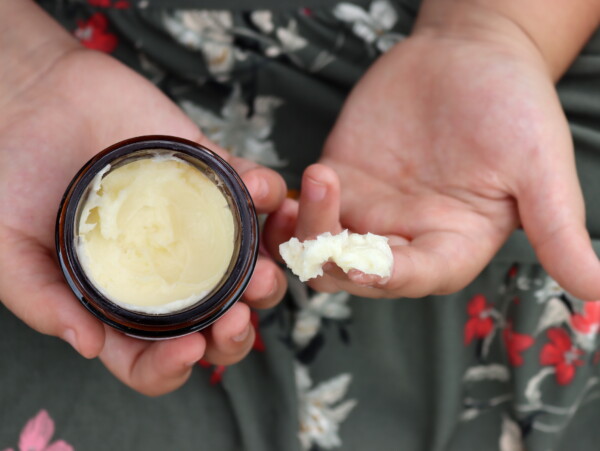
I liked the fact that it is helpful in so many ailments and it has been used for centuries